This article was originally published August 28, 2016. It has been updated to reflect new research published in 2018.
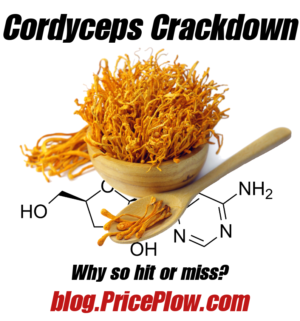
Cordyceps -- One of the biggest anomalies in the supplement industry. And we think we've finally figured out why.
Can a mushroom extract really improve mood, general health, and even athletic performance? Those who have been selling cordyceps, a complex mushroom used in Traditional Chinese Medicine, have claimed these benefits (and more) for years.
But when it came to actual scientific research, success has always been hit or miss. One study goes great, the next goes flat. Rats would love it, yet some humans would feel nothing.
So what's the deal with cordyceps? Why has it been so hit-or-miss? Have the researchers and supplement companies collectively been doing something wrong all these years?
The answer to that last question is yes.
But with the help of some new research, we've finally figured it out, and can at last put it to good use with the right cordyceps extract.
TL;DR
- Cordyceps is a genus of medicinal mushrooms (specifically, sac fungi) whose various extracts can "sometimes" increase lactate threshold and aerobic exercise capacity, depending on what study you look at.
- Cordyceps sinensis has been the most-marketed form in the 2000s. Unfortunately, cordyceps sinensis is commonly misidentified and DNA testing shows many supplements aren't even in the cordyceps family!
- Cordyceps militaris, however, seems to be the real deal, with new research showing improved VO2 max, peak power, and time to exhaustion.
- The best cordyceps supplement is currently Raw Nutrition Peak O2, which is targeted towards athletes and contains 2g of PeakO2, a formula led by cordyceps militaris. One scoop a day gets you clinically-studied benefits discussed below.
- No known side effects have been reported in healthy users.
Our story of cordyceps begins with the science on adaptogens.
Those elusive Adaptogens
Numerous herbs have been presented as adaptogens: Ginseng, Ashwaganda, Licorice Root, Rhodiola, and of course, Cordyceps. Our focus today will be on the mystical and elusive Cordyceps.
Cordyceps: What is it? Why is it used? What is its history of use?
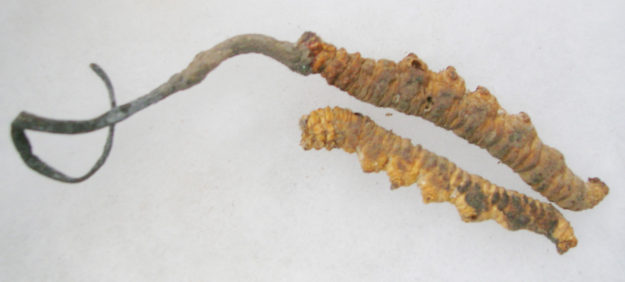
This is cordyceps sinensis. How is it that some research looks promising, but others fall flat? It turns out we sometimes end up with case of mistaken identity, and ultimately choose to avoid sinensis altogether!
In addition, and more along the lines of our readers may be interested in it, Cordyceps have also traditionally been used to help:
- Reduce stress,[1]
- Increase endurance,[1-3]
- Promote anabolism and muscle protein synthesis,[4]
- Improve glucose metabolism and insulin sensitivity[5,6]
- Boost virility[7,8]
- Improve general health.[6,9,10]
Several of the above traditional uses only have data from animal models (such as mice and rat studies) to support such claims, but the latest research on endurance is indeed human-based, prompting the creation of this article.
The medical history of cordyceps
Its use dates all the way back to the 15th century. In an ancient Tibetan medical text, An ocean of Aphrodisiacal Qualities, Zurkhar Nyamnyi Dorje outlines some uses of Cordyceps.[11] In fact, the fungus' Latin name comes from both its appearance and origin -- cordyceps means "club head," while sinensis translates to "from China."
Later on in 1972, cordyceps cultures found in Qinghai province in Central China were isolated by the Chinese Academy of Sciences. There a few different forms of Cordyceps with the most popular one being Cordyceps Sinensis, or "CS". Further, there were three strains that were first isolated. These strains were called CS-1, CS-2 and CS-3.
Unfortunately, mushrooms don't play by our rules. These cultures didn't grow very well in controlled settings,[12] which resulted in very little reproducible and repeatable research on it, limiting further exploration.
...and then came "CS-4"
Finally, however, the academy isolated the "CS-4" culture of "cordyceps" in 1989.[13,14] Unlike the previous ones, this one was far more suitable for growing and thus research being performed. Having so much variation and difficulty with this family of fungus already poses some problems, but science dragged forward because the community knew that something was there - it just had to be isolated.
Was this the solution to our cordyceps isolation problem? We thought so, but boy were we wrong.....
What’s it do? Proposed benefits of cordyceps supplementation
As listed above, cordyceps has traditionally been used to improve reproductive function,[8,15-17] prevent fatigue,[18] and slow the effects of aging.[19]
However, more recently there has been some investigation into its ergogenic or performance enhancement potential, as marketed by various companies with celebrity endorsements the past decade or so.
-
Decrease fatigue and increase endurance
Cordyceps Benefits: Mice can swim noticeably longer with hot-water fraction cultured cordyceps sinensis.[1] Why doesn't this always equate to humans, though, and how can we make it work?? Keep on reading...
Supplementation with cordyceps has been shown to increase physical endurance and decrease fatigue.[20] In one double-blind human trial, cordyceps significantly increased oxygen intake during exercise. Not only that, but it was also shown to decrease basal glucose and lactic acid levels. In a separate study, mice given cordyceps increased their swimming endurance from 75 to 90 minutes.[1]
In addition, a new cordyceps-based blend named PeakO2 has two clinical studies showing significant endurance increases (in terms of VO2max, VO2peak, lactate, and time to fatigue).[2,3] Those get covered further in depth later in the cordyceps militaris and PeakO2 sections.
-
Decreased stress levels
In the same first study referenced above, the researchers also noted a change in the weight of the mice's adrenal glands, spleens, thymus, and thyroids.[1] This indicated that the cordyceps users experienced less stress.
Why is this important, besides the obvious benefits? Athletically, less stress means less cortisol, which means less catabolism or muscle wasting and increased fat burn, amongst several other things.[21] It is extremely difficult to burn fat when cortisol levels are high.
-
Elevated cAMP levels
In a study published in the International Journal of Biochemical Cellular Biology, researchers found the cordyceps is able to elevate cAMP, but in a unique way, via the protein kinase A signal pathway, but not protein kinase C.[23]
Typically when people see cAMP elevation they think increased lipolysis and fat loss, yet it actually has other benefits as well. In this case, the researchers noted that cordyceps resulted in increased steroidogenesis via elevation of cAMP and StAR levels.[16] This brings us to our next benefit:
-
Increased testosterone levels in animal models
...These aren't "free gains" like a rookie gets using creatine for the first time. Rather, these are "performance gains"...
In several research studies, albeit using animal models, cordyceps has been shown to increase testosterone production, thus leading to anabolism. This is because cordyceps contain something known as polysaccharides. These are structurally very similar to luteinizing hormone (LH). Thus, when cordyceps are taken, they can mimic LH, which results in the observed increased testosterone levels.[23] A previously-mentioned paper published in The Journal of Life Sciences tested this hypothesis and found it to be true.[7] Interestingly, this had also already been established in the earlier 2003 study![21]
Note that nobody is promoting this for increased testosterone levels - it doesn't seem to have that massive of a response. The reason we mention it is to show that cordyceps is involved in several beneficial biological reactions, not detrimental ones.
How cordyceps works
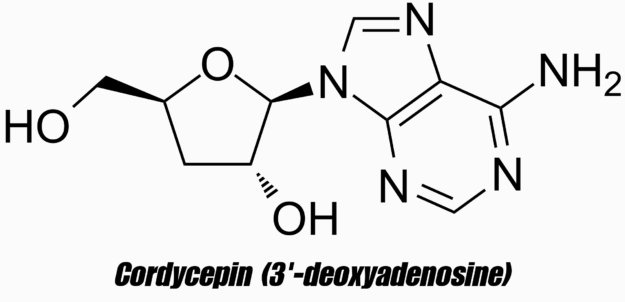
Meet Cordycepin, one of the key components to cordyceps. Some forms of cordyceps have more of this compound than others!
Cordycepin: Potent Immuno-Regulator with unique biological activities
Ironically, despite coming from what's essentially a fungus, cordycepin has also been shown to have antifungal properties. This was demonstrated by one study that infected mice with C. albicans 64 -- the control mice all died, yet 88% of the cordycepin-treated mice survived.[25]
Cordycepin also upregulates interleukin-10, which is an anti-inflammatory protein in the blood.[26]
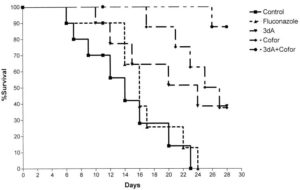
In this study, mice infected with C. albicans strain 64 had a greater survival rate when using cordycepin (3dA) alone but a far greater survival rate when used in combination with a drug named deoxycoformycin.[25] We emphasize this because far too often, people want to "pick sides" between modern medicine and natural treatment... when in reality, both have benefits and often work better together. Point being: this is NEVER a substitute for seeing your doctor - it's still a supplement.
In other processes, the polysaccharide "protects against the free radical-induced neuronal cell toxicity",[27] so there may be something going on with neuronal cell protection (cordyceps have often been marketed as nootropics and we expect to see more on this in the future).
Finally, anti-diabetic properties have been discovered while boosting nitric oxide levels,[28] which may lead further athletic-based research.
But in all honesty, the precise methods in which it works are still not fully understood. This is actually true for nearly all adaptogens - we simply haven't nailed the mechanisms of action (MOAs) for most of these ingredients, cordyceps included.
All in all, given the wide range of therapeutic properties, the Chinese herbalists seem to have been right about cordyceps, and cordycepin is likely a primary contributor to its benefits.
Where cordyceps sinensis fails and the research falls apart
While there is evidence for its effectiveness via mechanistic studies, animal studies, and even some human ones, there also exist quite a few not so great studies done on cordycep supplementation.
From one of those papers:
Time trial measurements did not differ between groups, nor did they change in response to supplementation. It is concluded that 5 weeks of CordyMax Cs-4 supplementation has no effect on aerobic capacity or endurance exercise performance in endurance-trained male cyclists.[22]
Another study had similar failings in terms of VO2 max and ventilatory threshold, although it was performed on elderly participants and there were some metabolic benefits found:[29]
Significant changes in metabolic or ventilatory threshold were not seen for the subjects in the placebo group after 12 weeks, and there were no changes in V̇O2 max in either group.[29]
So does it work or not?! What’s the deal here?!?!
Up until now most of the research being done on cordyceps has been on Cordyceps Sinensis (CS) (remember CS-1 through CS-4). So how can one study look so good, and the next be a total flop?
The answer is that mother nature has simply fooled us:
That’s not cordyceps you’ve been taking!
It turns out not all "cordyceps" is actually cordyceps!
That "cordyceps sinensis" you may have been purchasing... and the researchers have been using... may not actually be cordyceps sinensis!
For decades, identifying mushroom species was done by visual observation. Over time, researchers created a more scientific approach to identifying mushrooms using DNA sequencing.[30]
Who put Paecilomyces Hepiali (PH) in my cordyceps field?!
It turns out that the CS-4 we collectively thought was the "easy to grow" cordyceps... was not even cordyceps!! Much of it turned out to be the similar Paecilomyces Hepiali (PH)!
This fungus is part of a different genus called Paecilomyces and is not related to the Cordyceps Genus at all![31,32] Yet it looks almost exactly the same, leading researchers to believe it's just a derivative, at best.[33] With multiple sources of CS-4 being sold, it is absolutely possible some are actually P. Hepiali, while some others are indeed CS. We simply don't know.
The 2006 Wei paper mentioned above states in its abstract,
As to Paecilomyces hepiali, it was proved to be a distinct species outside Cordyceps sinensis and its anamorph.[31]
As basic evidence, just go to Google Images and search for "Paecilomyces Hepiali" to see the confusion -- you'll find yourself looking at images of CS-4 Cordyceps, which was grown from the mycelial strain Paecilomyces hepiali![29] Nobody without DNA sequencing technology seems to know the difference between these two!
But for more concrete evidence, a 2015 paper published in Mycology: An International Journal on Fungal Biology titled "Cordyceps industry in China" exposed the truth, stating,
Although P. hepiali was isolated from Chinese cordyceps, it should be regarded as an independent cordyceps fungus other than associated fungus of Chinese cordyceps based on its phylogenetic lineage.[14]
Funny enough, the original study from the Chinese Academy of Sciences that isolated "CS-4" was even titled "Research on Paecilomyces Hepiali",[13] leaving us to wonder how it started getting marketed as "cordyceps" in the first place.....
The final nail in the P. Hepiali / CS-4 coffin came recently in 2015, with a paper titled "Neotypification of Paecilomyces hepiali (Hypocreales)",[34] that once and for all isolated and established its true genetic code.
In short, just because it's associated with or grows along with cordyceps doesn't mean that it is cordyceps! But for 23 years, we were all collectively fooled, all to be saved by modern technology.
So now what?
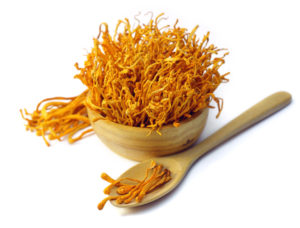
The answer to our confusion problems? Skip sinensis altogether... and go with these guys, cordyceps militaris!
With supplement raw materials manufacturers historically relying upon visual inspection (and that's if we're lucky they bothered to look), we'll never truly know what's been in some of those older "cordyceps supplements". They could very well have been Paecilomyces Hepiali instead. And while PH may have some benefits (such as anti-tumor properties[33]), from what we can see, they don't seem to extend to athletics and neuroprotection, the target for many cordyceps consumers.
So if it didn't work for you, or it didn't work in the study, you may now have a reason: misidentified raw materials, and possibly even flat-out deception.
Could this be the cause for the difference in athletic performance study results and spotty consumer feedback? We can't make guarantees, but we believe so. At this point, as athletes, we currently can't trust much of anything labeled "cordyceps sinensis", and definitely not "CS-4".
Realize once again that this doesn't make CS-4 bad, it's just not guaranteed to be pure cordyceps, and we don't see it having the athletic prowess it was hoped to have.
There's a way around it though: skip cordyceps sinensis altogether:
Cordyceps Militaris: The new deal in mushroom supplementation
Recently a new form cordyceps has entered the market: Cordyceps Militaris (CM), and it has left quite a mark, without the confusion of mistaken identity.
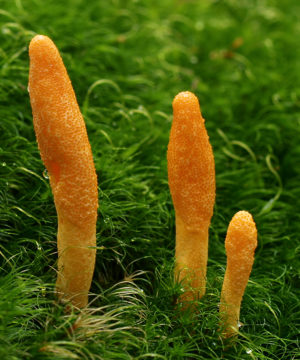
After doing the research, it looks like Cordyceps Militaris is the solution to a lot of problems in the Cordyceps Sinensis business. Image Courtesy Wikimedia.
Several research papers have historically reported that CM products contain higher levels of active ingredients than CS products. In a comparative study of the protective effects against oxidative damage, Militaris-based extracts were found to have higher antioxidant efficiency, higher contents of bioactive ingredients cordycepin and adenosine, higher polyphenolic contents, and higher flavonoid contents than CS extracts.[35]
Cordyceps militaris: more potent than cordyceps sinensis
Kim (2005) also found higher concentrations of exopolysaccharides and cordycepin in CM than in CS in submerged mycelial cultures.[12] In that study, cordyceps militaris had over twice the max cordycepin potency, which we believe to be one of the primary constituents as discussed above.
Cordyceps Militaris is also easier to grow in a cultured setting, allowing us to skip much of the trial-and-error we've had with Sinensis. But if we grow it in a lab, will that lead to diminished active ingredient yields? Doesn't look like it: Li (2001) reported strong anti-oxidation activity in Cordyceps and that the activity in cultured mycelium was equal or greater to that in the natural form.[36]
So now it's time to take this better-and-easier form of cordyceps to trial -- with endurance athletes:
Introducing PeakO2 by Compound Solutions: The Cordyceps Militaris Blend that works
In 2016, we finally got some legitimate evidence on trained athletes:
"Chronic, 3 week supplementation of a mushroom blend at 4 grams per day may improve VO2 max, increase Time to Exhaustion and augment Peak Power during high-intensity aerobic exercise.
A blend containing Cordyceps militaris may be an effective method for enhancing aerobic performance and delaying fatigue by improving oxygen kinetics. This could have positive implications for maintaining and improving training volume, especially in endurance athletes."[2]
This combination of mushrooms is now created and sold under the trademarked name PeakO2 by Compound Solutions, and we believe this cordyceps militaris blend is the "Next Big Thing" that cordyceps consumers have really been looking for all these years.
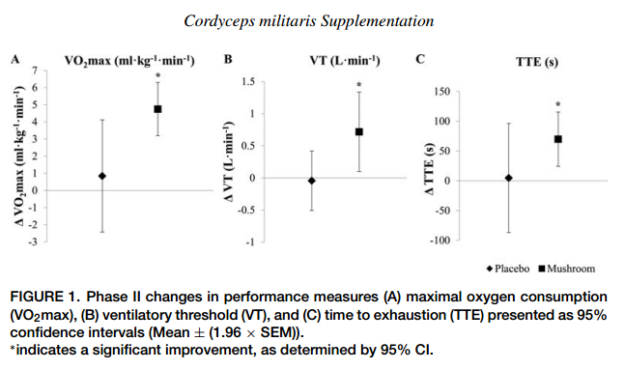
This incredibly-successful human study was actually done on a patented mushroom blend, named PEAKO2.[2] Is cordyceps militaris really where the action's at? We believe so.
In the above study, there was a significant increase in time to exhaustion. The researchers had subjects peddle at full speed for as long as they could, until they'd fall below a set resistance point. They then cut resistance out, let the subjects get speed back up, and then reintroduce the resistance again.

We were not paid by Compound Solutions (creators of PeakO2) nor Scivation to write this. Yet this is currently the only cordyceps we'll touch, so maybe we should have charged them!!
The goal in this type of study is to peddle all-out 100% for three minutes, which is impossible. However, when we say "significant increase in time", we mean that they added over a minute to the time before resistance was cut.
Think about this: How many non-hormonal supplements have given such noticeable/trackable impact in just seven days? This isn't a study done at some no-name university. It's UNC, and it's a randomized, double-blind, placebo controlled design.
Follow-up study: Lower Dose, Still Significant Endurance Benefits
While the above study was fantastic, the fitness community still wanted more proof, in the form of a follow-up study. In addition, 4g/day is quite a bit. It was postulated that a lower dose of PeakO2 taken for a longer period of time could still elicit significant endurance benefits.
Dudgeon, et al took to the task in 2018 in a study that had two trials:[3]
- Low-Dose (2g/day) over 28 days vs. Placebo
- High-Dose (12g/day) for 7 days vs. Placebo
After four weeks of supplementation, the low-dose group yielded the following:
- significant increase in time to fatigue,
- significant increase in VO2peak, and
- significant decrease in blood lactate levels
Meanwhile, the high-dose group also showed significant decreases in submaximal heart rate, an effect I have long noted on my heart rate monitor here at PricePlow. The high-dose group also had improved Peak Power Output, which may lend to a "mega-dosing" strategy a week before a competition. Note that these effects were more pronounced in individuals with less aerobic fitness.
How does cordyceps militaris work?
As mentioned above, adaptogens aren't fully understood. The data is strong and there are more studies in progress to better understand. Although there are theories, there's no proof yet. We're confident that cordycepin, described above, is a key player.
Mike McCandless, founder of Scivation, stated,
I'm blown away how effective PeakO2 is. I think it's the most effective supplement since creatine. Combined with BCAAs, it's a beautiful combo.
-- Mike McCandless, Scivation
What does all of this mean? As more studies come out, Cordyceps Militaris may prove to be a breakout supplement for the latter half of the 2010s. Cordyceps Sinensis just has too many question marks and identification problems.
So if you've tried cordyceps and didn't notice much, or cannot get repeatable results from bottle to bottle, our recommendation is to find a PeakO2-based formula, dose it at 2-4g per day as used in the studies above, and judge for yourself.
What is the best cordyceps supplement?
Given the sinensis and CS-4 identification problems, we're sticking to cordyceps militaris for the time being, and PeakO2 is the one ingredient blend from a trusted raw materials supplier that has actual research performed on it.
Note, however, that PeakO2 is a blend that's led by cordyceps militaris, but has other beneficial mushroom constituents as well, which could definitely play a part in the success of those studies. How much those other ingredients contribute to PeakO2's early success versus just cordyceps militaris is impossible to determine. Ultimately, we're interested in the end results and benefits, and if it takes a mushroom blend to make it work best for athletes, then so be it.
Since writing this article, several PeakO2-based supplements have come out, many with great success. But the Xtend brand was first to do it, and their Xtend Elite BCAA supplement included even more beneficial endurance ingredients, including Beta Alanine and Citrulline Malate. This is an amino acid supplement that you typically drink during your workout. It's dosed at 2g/scoop, so over the course of a month, you can replicate Dudgeon's 2018 study (and then some, thanks to the added ingredients).
To replicate Hirsch's study at UNC, two servings per day are to be used, but that will of course affect your budget twice as hard.
As with all other Xtend products, it contains 7g branched chain amino acids that will help keep muscle tissue in an anti-catabolic state and prevent them from breaking down, likely helping to increase endurance and recovery as well.
RAW Nutrition Peak O2 – Deals and Price Drop Alerts
Get Price Alerts
No spam, no scams.
Disclosure: PricePlow relies on pricing from stores with which we have a business relationship. We work hard to keep pricing current, but you may find a better offer.
Posts are sponsored in part by the retailers and/or brands listed on this page.
How to take it
Our recommended dosing protocol is to use it pre-workout, or if using an intra-workout supplement, to use it throughout your workout.
Update: See also PrimaForce Peak O2
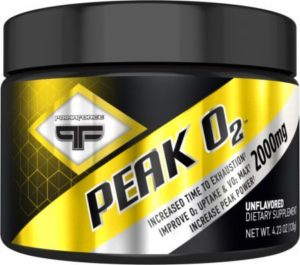
PrimaForce Peak O2 has sixty 2g servings of the extract, straight from Compound Solutions! Click here to compare prices.
If you want to try PeakO2 all on its own, PrimaForce now has a standalone version of this cordyceps / mushroom extract from Compound Solutions!
PrimaForce Peak O2 is a standalone supplement that simply contains 120g of the extract - enough for sixty 2g servings!
You can then add this to your own favorite BCAA supplement, pre workout supplement, energy drink, etc.
We tried it raw and can guarantee that it won't taste too good all alone in water, but we know how some of you are!! It's worth at least dipping your finger in to try the "earthy" taste. What we've discovered is that sweeter drinks mask it best.
PrimaForce Peak O2 – Deals and Price Drop Alerts
Get Price Alerts
No spam, no scams.
Disclosure: PricePlow relies on pricing from stores with which we have a business relationship. We work hard to keep pricing current, but you may find a better offer.
Posts are sponsored in part by the retailers and/or brands listed on this page.
Any Side Effects to Cordyceps Militaris or PeakO2?
So... will it make my athlete's foot flare up? To this point, no significant side effects have been noticed. It's a fully intact mushroom, no weird isolations.
Quite the opposite, in fact
When exploring the research looking for side effects of cordyceps, it's actually more common to see cordyceps used as a conjunctive therapy alongside aggressive medical treatments to help prevent side effects of those treatments!
That's out of the scope of this document, but the point is that we haven't found a single problem - at least not in the doses studied.
Originally launched in Scivation Xtend Perform
Scivation, the former owners of Xtend BCAAs, originally launched PeakO2 in Xtend Perform, and we were honored to be early reviewers. Xtend Perform was subsequently replaced by Xtend Elite, which is now also discontinued.
My original month on Xtend Perform was one of the most interesting supplement runs I've ever taken. When in the gym, I work out with a heart rate monitor (the good kind across my chest, not that FitBit nonsense), and try to work towards certain BPM ranges.
The first thing I noticed was that my heart rate was noticeably lower for similar exercises! Whereas one exercise, such as 5x275 deadlifts would get me up to 155BPM, this would become 145 after I was a week into Xtend Perform!
I don't know what exactly this means, but I'm guessing that I had better oxygen utilization, and my cardiovascular system needed to do less work.
Meanwhile, in the pool, my breathing pattern became way easier. I've been swimming for 30 years and know when something different is going on. When it becomes this easy to breathe every five or seven strokes rather than every three, something good is happening.
But does it mean *gains*?
Now, does this translate to gains? This is where the argument begins. Marketers will tell you that you will then lift more (power) for more reps (endurance) and recover quicker (VO2). With more research, this may become a "better beta alanine".
I would argue that I could sustain harder workouts for longer periods of time, but what does that ultimately mean? If you're not taking advantage of these improvements and actually bumping your weight/volume up, but are instead just enjoying easier breathing and such, then you're probably wasting your time and money.
Point being, these aren't "free gains" like a rookie gets when using creatine for the first time, or going on a hormone cycle. Rather, these are "performance gains", which only translate into body composition gains if you're feeding yourself and recovering properly.
Wrapping it up: What now? Who is this for?
At the end of the day, any time you improve the body's ability to use oxygen, it's a good thing.
We're only scratching the surface here, and believe there will be further applications in medical fields as well as supplement niches such as nootropics / cognitive focus agents. And don't forget about the possible testosterone boost via cAMP, even if it's slight.
Is cordyceps militaris a must-have, low-cost supplement like protein, creatine, or betaine? No, it honestly isn't.
Is it a game-changer if you're doing the same old slap-dick 3 sets of 10, three times a week workout, and never leave the gym exhausted in the first place? No, it's not. In this case, your troubles are elsewhere.
But if you're an endurance athlete, or heading into a serious stretch of high-volume training, is PeakO2 something you should seriously consider? If you have the budget, right now we say YES.
RAW Nutrition Peak O2 – Deals and Price Drop Alerts
Get Price Alerts
No spam, no scams.
Disclosure: PricePlow relies on pricing from stores with which we have a business relationship. We work hard to keep pricing current, but you may find a better offer.
Posts are sponsored in part by the retailers and/or brands listed on this page.
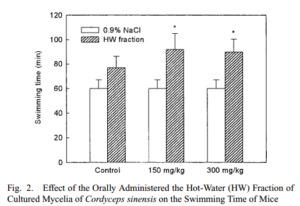
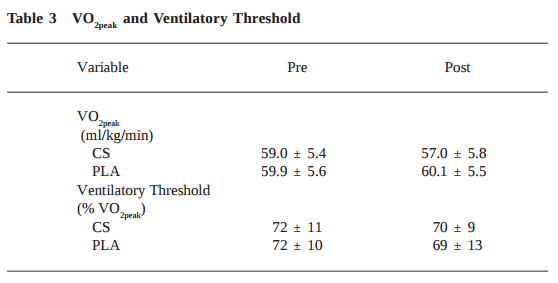
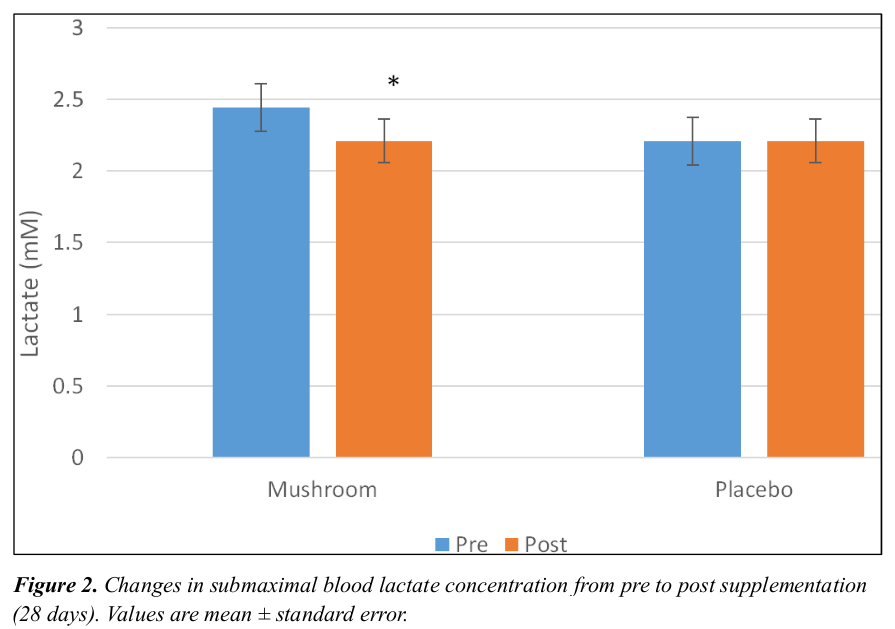
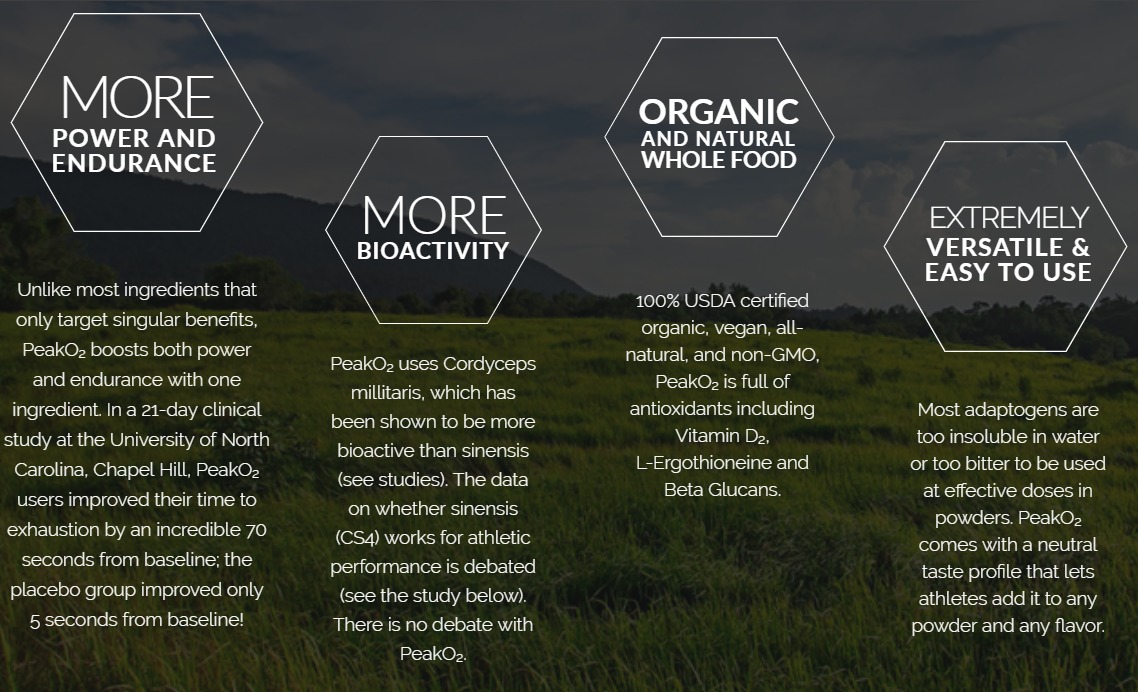


Comments and Discussion (Powered by the PricePlow Forum)